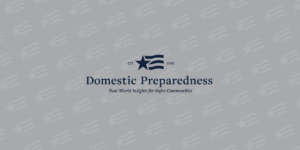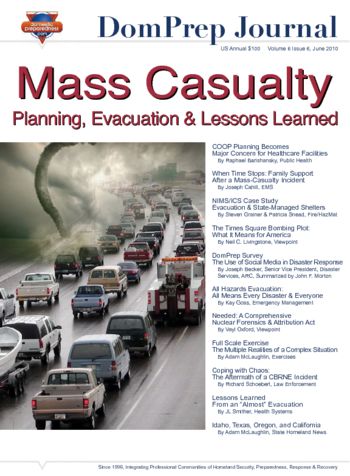
Needed: A Comprehensive Nuclear Forensics and Attribution Act
Vayl S. Oxford
June 30, 2010
U.S. homeland-security capabilities have improved immensely over the past decade. But there are
still too many gaps – in funding, in legislative authority, and in the dwindling pool of career-minded
nuclear scientists and engineers. A distinguished former DNDO official discusses some important steps
the executive and legislative branches of government can take to remedy current deficiencies and upgrade
overall U.S. nuclear capabilities.

FINAL REPORT: The Use of Social Media in Disaster Response
Joseph C. Becker and John F. Morton
June 30, 2010
The DP40 and DomPrep readers assess their opinions on the use of “social media” (Twitter, Facebook,
etc.) in disaster response. The issues are important and may require the setting of policies –
particularly in view of the legal ramifications involved with regard to liability.

CDW-G's Seven Habits of Highly Resilient Organizations
Domestic Preparedness
June 29, 2010
Faced with the National Oceanic and Atmospheric Administration’s (NOAA) Climate Prediction Center’s warning of a 2010 hurricane season eerily similar to 2005, many state and local government officials are asking

Coping with Chaos: The Aftermath of a CBRNE Incident
Richard Schoeberl
June 23, 2010
U.S. emergency managers and worst-case planners have been warning for many years that the possibility of a WMD attack against American cities is a “when, not if” scenario. The nation’s ability to prevent, respond to, and recover from such an attack is much improved. But there are still serious deficiencies, greater national and international cooperation is needed, and improved technological capabilities as well. Meanwhile, the sands of time are running out, and even tomorrow could be too late.

All Hazards Evacuations: All Means Every Disaster & Everyone
Kay C. Goss
June 23, 2010
No one – whether they be political decision makers, first responders, or individual citizens – will
ever be satisfied with less than perfect safety. But major advances have been made in detection,
deterrence, and response. One of the most important but relatively unpublicized advances is in the field
of crowd control and evacuations, once an afterthought but now an essential component of the emergency
manager’s preparedness toolkit.

Lessons Learned From an 'Almost' Evacuation
Jennifer Smither
June 23, 2010
In December 2014, an unknown patient zero visited Disneyland in California. Whether that person knew that he or she was carrying a highly contagious infectious disease is not as important as the speed in which the disease spread and the reason behind it. There is a correlation between the resurgence of measles and vaccination practices in modern families.

When Time Stops: Family Support After a Mass-Casualty Incident
Joseph Cahill
June 16, 2010
The rapid growth of mass-casualty incidents in recent years has led to much-needed new rules – now formulated at the federal level – to not only notify victims’ families and friends, and usually the media as well. Implementing those rules requires organizational skills, advance planning, compassion,
and an uncommon measure of common sense.

NIMS/ICS Case Study: Evacuation & State-Managed Shelters
Stephen Grainer and Patricia Snead
June 16, 2010
If a hotel has been overbooked most people go to another hotel just a block or two away. That solution does not work when a mass-casualty incident requires the evacuation of hundreds, perhaps thousands, of citizens. Immediately. Which is why local evacuation plans must anticipate the need for additional sheltering sites to house those forced out of their homes.

DomPrep Survey: The Use of Social Media in Disaster Response
Domestic Preparedness and
June 16, 2010
This survey focuses attention on use of the “social media” (Twitter, Facebook, etc.) in
disaster-response situations. Several of the DP40 views are surprising; others – involving liability
issues, for example – are mandates for quick and effective action. DPJ readers are hereby respectfully
requested to Take the Survey Now!!

CDC Public Health Assessment and Surveillance After a Disaster: Tools & Forms
Domestic Preparedness
June 15, 2010
CDC (The Centers for Disease Control and Prevention) has developed forms and toolkits – such as the Mortality Surveillance form, the Shelter Assessment Tool, the Community Assessment for Public Health






